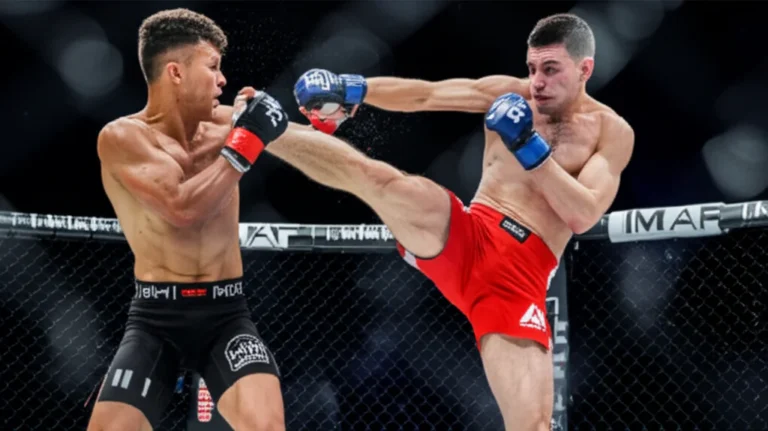Support our educational content for free when you purchase through links on our site. Learn more
What States Is MMA Illegal In? The 2025 Truth Revealed 🥋
Did you know that as recently as 2016, MMA was banned in one of the biggest states in the US—New York? It’s hard to believe now, with UFC events filling arenas coast to coast, but the legal landscape of MMA has been a wild ride. If you’ve ever wondered “What states is MMA illegal in?”, you’re about to get the knockout answer straight from the experts at MMA Ninja™. Spoiler alert: No state currently bans professional MMA, but the story behind how we got here is packed with drama, politics, and some surprising twists.
In this comprehensive guide, we’ll break down the history of MMA legality, reveal which states once stood in the way, explain how athletic commissions keep fighters safe, and peek into the future of MMA regulation. Whether you’re a fighter, promoter, or fan, understanding this legal maze is crucial—and we’ll show you exactly where MMA stands today and why.
Key Takeaways
- All 50 US states currently allow professional MMA competitions, with New York being the last to legalize in 2016.
- State athletic commissions regulate MMA, ensuring safety through licensing, medical checks, and enforcing the Unified Rules.
- Some states like Alaska and Montana operate without formal commissions but still permit MMA under alternative regulations.
- Historical bans were driven by safety concerns, political opposition, and lack of regulatory infrastructure.
- Understanding local and state regulations is essential for fighters, promoters, and fans to navigate the MMA scene safely and legally.
Ready to gear up or learn more? Check out top MMA gear and official fight equipment from brands like Venum and Hayabusa to train like a pro!
- 👉 Shop MMA Gear:
Table of Contents
- ⚡️ Quick Tips and Facts About MMA Legality in the US
- 🥋 The Evolution and Legal History of MMA in America
- 🗺️ Which States Have Banned or Restricted MMA? The Definitive List
- 📜 Understanding State Athletic Commissions and MMA Regulations
- ⚖️ Why Is MMA Illegal or Restricted in Certain States? Key Reasons Explained
- 🥊 How MMA Legality Impacts Fighters, Promoters, and Fans
- 🌎 Comparing MMA Legality: US States vs. International Perspectives
- 💡 What’s Next? The Future of MMA Legislation in the United States
- 📚 Recommended Resources for MMA Laws and Regulations
- ❓ Frequently Asked Questions About MMA Legality
- 🔗 Reference Links and Official Sources on MMA Legality
- 🎯 Conclusion: Navigating the Legal Landscape of MMA in the US
⚡️ Quick Tips and Facts About MMA Legality in the US
If you’re wondering what states is MMA illegal in, you’re in the right dojo! At MMA Ninja™, we’ve been in the cage, on the mats, and behind the scenes, so here’s the lowdown:
- ✅ MMA is legal in all 50 states as of 2016, with New York being the last to legalize professional MMA competitions.
- ❌ Some states had bans or restrictions historically, but today, no state outright bans MMA; however, local regulations and athletic commissions vary.
- 🥋 State Athletic Commissions regulate MMA events, ensuring fighter safety, rules enforcement, and event licensing.
- ⚠️ A few states like Alaska and Montana have no athletic commission but still allow MMA under other regulatory frameworks.
- 🔥 The Unified Rules of MMA are the gold standard across the US, adopted to standardize competition and safety.
- 🎯 MMA’s explosive growth in the US is backed by major promotions like UFC, Bellator, and PFL, all operating nationwide.
Curious about the journey MMA took to get here? Let’s dive deeper!
🥋 The Evolution and Legal History of MMA in America
MMA’s path to legality in the US is a rollercoaster worthy of a highlight reel. From underground brawls to ESPN broadcasts, here’s the story:
The Early Days: From “No Holds Barred” to Regulated Sport
Back in the 1970s and 80s, MMA was more of a wild west spectacle. The “Tough Guy Contest” in Pennsylvania (1980) was one of the first attempts to regulate MMA, but it was quickly shut down by the state senate in 1983. The sport was often labeled as “human cockfighting,” a phrase famously used by Senator John McCain in the 1990s, which fueled bans in states like New York.
The Gracie Revolution and UFC’s Rise
The Gracie family brought Brazilian jiu-jitsu to the US in the early 90s, culminating in the first UFC event in 1993. This was a game-changer, showcasing a real martial arts contest rather than a street fight. Over time, the Unified Rules of Mixed Martial Arts were developed, introducing weight classes, rounds, and safety measures.
Legalization Milestones
- New Jersey (2000): First state to regulate MMA officially.
- West Virginia (2011), Wyoming (2012), Vermont (2012), Connecticut (2013): Followed suit.
- New York (2016): The last holdout, finally legalizing MMA after years of debate.
Today, MMA is the fastest-growing spectator sport in the US, with millions tuning in every fight night. Want to know which states had the toughest bans? Keep reading!
For more on MMA’s roots and history, check out our MMA History category.
🗺️ Which States Have Banned or Restricted MMA? The Definitive List
Here’s the knockout answer: No US state currently bans professional MMA outright. But historically, some states either banned it or had no regulatory framework, causing confusion.
| State | MMA Status Today | Notes |
|---|---|---|
| New York | ✅ Legal (since 2016) | Last state to legalize; previously banned since 1997. |
| Alaska | ✅ Legal, no commission | No athletic commission but MMA events happen under other regulations. |
| Montana | ✅ Legal, no MMA regulation | Has a commission but does not regulate MMA specifically; fights still occur legally. |
| Pennsylvania | ✅ Legal | Early bans lifted; now fully regulated. |
| California | ✅ Legal | One of the first states with a strong athletic commission regulating MMA. |
| Florida | ✅ Legal | Major MMA hub with many promotions. |
Historical Bans and Restrictions
- New York: Banned MMA from 1997 to 2016.
- Pennsylvania: Banned “Tough Guy” contests in the 80s.
- Other states: Some had patchy or unclear regulations before adopting the Unified Rules.
Why the Confusion?
Some states have no athletic commission or specific MMA regulations, which can make it seem like MMA is “illegal” or unregulated, but that’s not the same as a ban.
Our Take at MMA Ninja™
If you’re a fighter or fan, always check local regulations before attending or organizing events. Even in legal states, city or county rules can vary.
📜 Understanding State Athletic Commissions and MMA Regulations
State Athletic Commissions are the referees outside the cage, making sure everything runs smoothly and safely.
What Do Athletic Commissions Do?
- License fighters, promoters, and officials.
- Enforce Unified Rules of MMA.
- Conduct drug testing and medical exams.
- Approve venues and event safety protocols.
Examples of Major State Commissions
| State | Commission Name | Website |
|---|---|---|
| Nevada | Nevada State Athletic Commission | nsac.nv.gov |
| California | California State Athletic Commission | www.dca.ca.gov/csac |
| New Jersey | New Jersey State Athletic Control Board | www.nj.gov/lps/sacb |
What Happens in States Without Commissions?
Alaska and Montana, for example, lack formal commissions but allow MMA under other regulatory bodies or tribal authorities. This can affect fighter insurance and event legitimacy.
MMA Ninja™ Insight
We’ve seen fighters struggle with licensing in commission-less states, so having a commission is a big plus for professional careers.
For a deep dive into MMA regulations, visit our MMA Coaching category.
⚖️ Why Is MMA Illegal or Restricted in Certain States? Key Reasons Explained
Even though MMA is legal nationwide now, the historical resistance wasn’t random. Here’s why some states hesitated:
1. Safety Concerns
Early MMA had a reputation for being brutal and unregulated, raising fears about fighter injuries and deaths. Critics called it “no holds barred,” which scared lawmakers.
2. Political and Cultural Opposition
Figures like Senator John McCain campaigned against MMA, calling it “human cockfighting.” This stigma influenced public opinion and legislation.
3. Lack of Regulation Infrastructure
Some states lacked athletic commissions or the resources to regulate a complex sport like MMA, leading to bans or moratoriums.
4. Insurance and Liability Issues
Promoters and venues worried about liability without clear rules and insurance frameworks.
5. Competition with Boxing and Other Sports
Boxing commissions sometimes resisted MMA, fearing competition or loss of control.
MMA Ninja™ Perspective
The Unified Rules of MMA and modern athletic commissions have addressed most concerns, turning MMA into a respected sport with safety protocols rivaling boxing and football.
🥊 How MMA Legality Impacts Fighters, Promoters, and Fans
The legal status of MMA isn’t just a bureaucratic detail—it shapes the entire ecosystem.
For Fighters
- ✅ Legal states offer licensing, medical oversight, and insurance.
- ❌ In unregulated areas, fighters risk unsafe conditions and lack of career legitimacy.
For Promoters
- ✅ Regulated states provide clear guidelines and legitimacy, attracting bigger sponsors and audiences.
- ❌ Without regulation, promoters face legal risks and difficulty securing venues.
For Fans
- ✅ Legal MMA means more events, better production, and safer fighters.
- ❌ Illegal or unregulated MMA means fewer shows and potential safety concerns.
Real Story from MMA Ninja™
One of our fighters once had to travel out-of-state just to compete legally because his home state lacked proper MMA regulation. It’s a hassle that impacts careers and dreams.
🌎 Comparing MMA Legality: US States vs. International Perspectives
MMA’s legal landscape varies wildly worldwide. Here’s a quick global snapshot compared to the US:
| Country | MMA Legal Status | Notes |
|---|---|---|
| Brazil | ✅ Legal, regulated by CABMMA | Home of many top fighters; strong national commission. |
| Canada | ✅ Mostly legal, some provinces restrict | Newfoundland, PEI, Saskatchewan still have restrictions. |
| Mexico | ✅ Legal, regulated by FAMM-EJL | Growing MMA scene with official oversight. |
| Norway | ❌ Professional MMA illegal | Knockout sports banned historically; boxing exception recently made. |
| Australia | ✅ Legal in all states | Some cage bans lifted after controversy. |
| United States | ✅ Legal in all states | Nationwide regulation with some local variations. |
Why the US Stands Out
The US’s state-by-state regulation model is unique compared to countries with national commissions. This can create patchwork rules but also allows regional flexibility.
For more on MMA worldwide, check out our Fighter Profiles and MMA Industry News.
💡 What’s Next? The Future of MMA Legislation in the United States
MMA’s legal battles are mostly behind us, but the sport keeps evolving:
Potential Developments
- Unified national regulation? Some advocate for a federal MMA commission to standardize rules and licensing.
- More fighter protections: Enhanced medical protocols, concussion protocols, and insurance reforms.
- Expansion of women’s MMA: More states and commissions supporting female fighters and events.
- Emerging markets: Tribal lands and smaller jurisdictions may develop their own MMA regulations.
MMA Ninja™ Prediction
We foresee continued growth and professionalization, with MMA becoming as mainstream and regulated as boxing or football. The days of bans and confusion are fading fast.
📚 Recommended Resources for MMA Laws and Regulations
Want to keep your knowledge sharp? Here are some top resources:
- Association of Boxing Commissions (ABC) — Oversees MMA commissions in the US.
- Nevada State Athletic Commission — One of the most influential MMA regulators.
- Unified Rules of Mixed Martial Arts — Official rulebook.
- MMA Ninja™ MMA Coaching — For training and regulatory insights.
- MMA History — Deep dives into the sport’s evolution.
❓ Frequently Asked Questions About MMA Legality
Q: Is MMA legal everywhere in the US now?
A: ✅ Yes! Since 2016, all 50 states have legalized professional MMA competitions.
Q: Are there any states without athletic commissions?
A: Yes, Alaska and Montana don’t have formal commissions but still allow MMA under other regulations.
Q: Can amateur MMA be banned even if pro MMA is legal?
A: Sometimes, yes. Amateur MMA is regulated differently and may face local restrictions.
Q: Why was MMA banned in New York for so long?
A: Due to safety concerns, political opposition, and lack of regulation infrastructure until 2016.
Q: How do athletic commissions protect fighters?
A: Through licensing, medical checks, drug testing, and enforcing safety rules.
🔗 Reference Links and Official Sources on MMA Legality
- Legality of professional MMA competitions – Wikipedia
- Mixed martial arts in the United States – Wikipedia
- Nevada State Athletic Commission
- Association of Boxing Commissions
- Unified Rules of MMA
- New Jersey State Athletic Control Board
Ready to learn more about MMA’s thrilling world? Check out our article on What is MMA and UFC? to get started!
🎯 Conclusion: Navigating the Legal Landscape of MMA in the US
So, what’s the final bell on what states is MMA illegal in? The answer is a resounding no state currently bans professional MMA in the United States. After decades of legal battles, political pushback, and evolving safety standards, MMA has firmly planted its flag nationwide. From the early days of underground “Tough Guy” contests to the glitzy UFC pay-per-views, the sport’s journey is a testament to perseverance and regulation.
At MMA Ninja™, we’ve seen firsthand how the establishment of Unified Rules and state athletic commissions transformed MMA from a misunderstood spectacle into a respected sport. While some states like Alaska and Montana operate without formal commissions, they still allow MMA events under alternative regulatory frameworks. This patchwork system may seem complex, but it ultimately ensures fighter safety and event legitimacy.
If you’re a fighter, promoter, or fan, understanding the legal landscape is crucial. Always check local regulations, especially for amateur events or smaller promotions. The future looks bright with ongoing efforts to enhance fighter protections and possibly unify regulations further.
Ready to jump into the cage or just want to stay informed? Keep training, keep watching, and keep questioning — MMA’s story is still being written, and you’re part of it!
📌 Recommended Links
Looking to gear up or dive deeper into MMA? Here are some top picks from the MMA Ninja™ team:
-
👉 Shop MMA Gear and Equipment:
-
Books on MMA History and Techniques:
- The Fighter’s Mind: Inside the Mental Game by Sam Sheridan — Amazon Link
- Mixed Martial Arts: The Book of Knowledge by B.J. Penn — Amazon Link
- A Fighter’s Heart by Sam Sheridan — Amazon Link
-
MMA Regulatory Resources:
❓ Frequently Asked Questions About MMA Legality
Is MMA legal in all 50 states?
Yes! As of 2016, all 50 US states have legalized professional MMA competitions. New York was the last state to legalize MMA after a long ban dating back to 1997. While some states like Alaska and Montana do not have formal athletic commissions, MMA events are still permitted under alternative regulatory frameworks. This means you can enjoy or participate in MMA anywhere in the country, but always check local rules for amateur bouts or smaller promotions.
What are the laws and regulations surrounding MMA in the United States?
MMA in the US is regulated primarily at the state level by athletic commissions. These commissions license fighters, promoters, and officials, enforce the Unified Rules of Mixed Martial Arts, conduct medical and drug testing, and ensure event safety. The Unified Rules, established in the early 2000s, standardized weight classes, rounds, fouls, and safety protocols, making MMA safer and more professional. Some states without commissions still allow MMA under tribal or other regulatory bodies, but having a commission generally means better oversight and fighter protections.
Why was MMA banned in some states?
Early MMA faced bans due to safety concerns, political opposition, and a lack of regulatory infrastructure. The sport’s initial reputation as a brutal, no-holds-barred spectacle led to fears of serious injuries and even death. Influential figures like Senator John McCain publicly condemned MMA as “human cockfighting,” which swayed public opinion and lawmakers. Additionally, some states lacked the resources or commissions to regulate MMA properly, leading to outright bans or moratoriums. Over time, the development of the Unified Rules and commissions helped overcome these barriers.
How has the legalization of MMA changed over time in the US?
MMA’s legalization journey is a story of gradual acceptance and regulation:
- 1980s: Early attempts like Pennsylvania’s “Tough Guy” contests were banned.
- 1990s: UFC’s debut popularized MMA but faced political backlash and bans in states like New York.
- 2000s: New Jersey became the first state to regulate MMA officially, paving the way for others.
- 2010s: Most states adopted regulations; New York legalized MMA in 2016, completing nationwide legalization.
- Today: MMA is a mainstream sport with robust safety standards, growing female participation, and expanding global reach.
How do athletic commissions protect MMA fighters?
Athletic commissions play a vital role in fighter safety by:
- Licensing fighters to ensure they meet health and skill standards.
- Mandating pre-fight medical exams and post-fight medical suspensions.
- Conducting drug testing to prevent performance-enhancing drug use.
- Enforcing the Unified Rules to minimize dangerous techniques and fouls.
- Approving venues and ensuring emergency medical services are present at events.
These measures reduce risks and promote fair competition, helping MMA gain legitimacy and respect.
Can MMA be banned or restricted at a local level despite state legality?
Yes, while states regulate MMA broadly, local municipalities or counties may impose additional restrictions or bans on events. This can affect where promoters can hold fights or whether amateur MMA is permitted. Fighters and fans should always verify local regulations before attending or organizing events.
🔗 Reference Links and Official Sources on MMA Legality
- Legality of professional MMA competitions – Wikipedia
- Mixed martial arts in the United States – Wikipedia
- Nevada State Athletic Commission
- Association of Boxing Commissions
- Unified Rules of Mixed Martial Arts – ABC
- New Jersey State Athletic Control Board
- Athletic Commission | Department of State – New York
At MMA Ninja™, we’re always here to help you navigate the thrilling, complex world of mixed martial arts. Whether you’re stepping into the cage or just a passionate fan, understanding the legal landscape keeps you one step ahead. Keep training hard and stay informed! 🥋🔥






